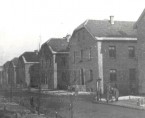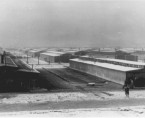Life in the camp
Living conditions
Auschwitz Concentration Camp opened in former Polish army barracks in June 1940. Twenty brick buildings were adapted, of which 6 were two-story and 14 were single-story. At the end of 1940, prisoners began adding second stories to the single-story blocks. The following spring, they started erecting 8 new blocks. This work reached completion in the first half of 1942. The result was a complex of 28 two-story blocks, the overwhelming majority of which were used to house prisoners. As a rule, there were two large rooms upstairs and a number of smaller rooms downstairs. The blocks were designed to hold about 700 prisoners each after the second stories were added, but in practice they housed up to 1,200.
During the first several months, the prisoners’ rooms had neither beds nor any other furniture. Prisoners slept on straw-stuffed mattresses laid on the floor. After reveille in the morning, they piled the mattresses in a corner of the room. The rooms were so overcrowded that prisoners could sleep only on their sides, in three rows. Three-tiered bunks began appearing gradually in the rooms from February 1941. Theoretically designed for three prisoners, they in fact accommodated more. Aside from the beds, the furniture in each block included a dozen or more wooden wardrobes, several tables, and several score stools. Coal-fired tile stoves provided the heating.
In the first months, the prisoners drew water from two wells and relieved themselves in a provisional outdoor latrine. After the rebuilding of the camp, each building had lavatories, usually on the ground floor, containing 22 toilets, urinals, and washbasins with trough-type drains and 42 spigots installed above them. The fact that prisoners from the upstairs and downstairs had to use a single lavatory meant that access was strictly limited.
Two types of barracks, brick and wooden, housed prisoners in the second part of the camp, Birkenau. The brick barracks stood in the oldest part of the camp, known as sector BI, where construction began in the fall of 1941. Inside each of them were 60 brick partitions with three tiers, making a total of 180 sleeping places, referred to as “buks,” designed to accommodate 4 prisoners. The SS therefore envisioned a capacity of over 700 prisoners per block. At first, the buildings had earthen floors. Over time, these were covered with a layer of bricks lying flat, or with a thin layer of poured concrete. The barracks were unheated in the winter. Two iron stoves were indeed installed, but these were insufficient to heat the entire space. Nor were there any sanitary facilities in the barracks. Only in 1944 were sinks and toilets installed in a small area inside each block. Nor was there any electric lighting at the beginning.
Wooden stable-type barracks were installed in segment BI, and above all in segments BII and BIII. These barracks had no windows. Instead, there was a row of skylights on either side at the top. A chimney duct, which heated the interior in the winter, ran almost the entire length of the barracks. The interior was divided into 18 stalls, intended originally for 52 horses. The two stalls nearest the door were reserved for prisoner functionaries, and containers for excrement stood in the two stalls at the far end. Three-tier wooden beds or three-tier wooden bunks intended for 15 prisoners to sleep in were installed in the other stalls, for a total capacity of more than 400 prisoners per barracks.
In the brick blocks, prisoners slept on straw strewn on the boards of the buks; paper mattresses stuffed with so-called “wood wool” were placed on the beds or bunks in the wooden barracks.
The number of prisoners that the barracks were supposed to hold should be treated as only a starting point, since the actual number was often much higher. It varied according to the size and number of transports arriving at any given time.
During the first year or so, water in sector BI was available only in the kitchen barracks, and prisoners had no access to it. Unable to wash, they went around dirty. They had to perform their bodily functions in unscreened outside privies. The barracks were frequently damp, and lice and rats were an enormous problem for the prisoners. It is therefore hardly strange that epidemics of contagious diseases erupted frequently. Sanitary conditions improved to a certain degree in 1943, when each part of the camp was outfitted with a bathhouse and equipment for disinfecting clothing and linen. Nevertheless, the capacity of these facilities in proportion to the number of prisoners limited the possibilities for making use of them. In sector BI, for instance, there were 4 barracks with sinks for washing (90 spigots per barracks), 4 toilet barracks (a sewer with a concrete lid that had 58 toilet openings in it), and 2 barracks containing toilets and sinks—for a sector containing 62 barracks housing prisoners. The prisoners also had limited opportunities for bathing. Additionally, they had to undress in their own barracks before doing so and, regardless of the weather, walk naked to the bathhouse. For many prisoners, this led to sickness and death.

